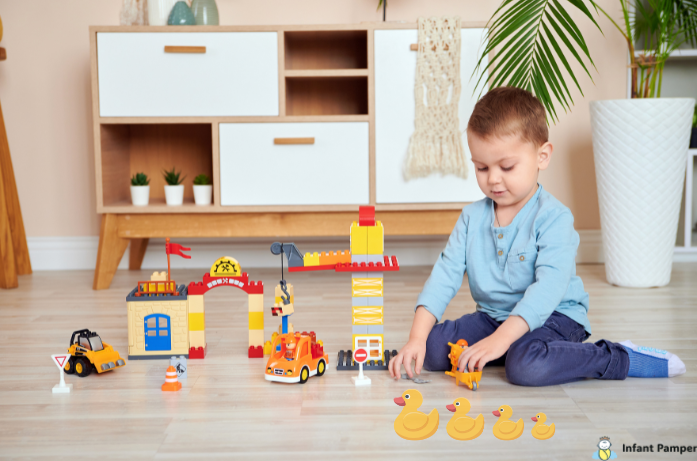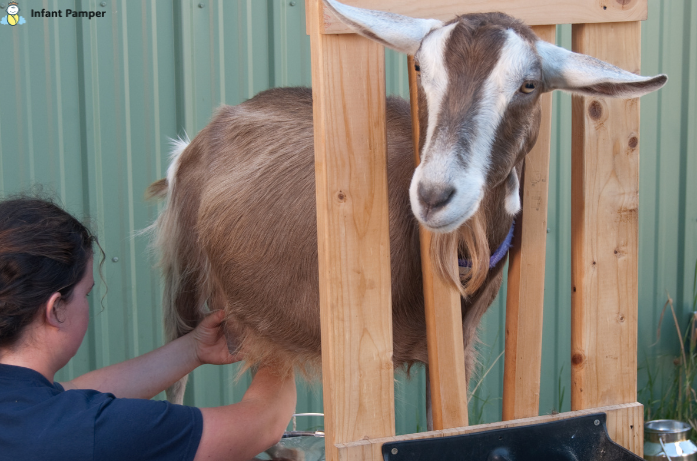Carefully crafted by the Infant Pamper Team
Your child’s growth and development mean the world to you. The toddler years are packed with milestones, explorations, and endless learning. One of the best supports to this stage is with certain Montessori toys for toddlers that have been designed to enhance a young child’s independence, creativity, and critical thinking.
In this guide, you’ll learn what makes Montessori toys so potent, how to choose them, and the best way to work with them at home. Whether you are just starting out with Montessori education or you are an ardent supporter, this article will put your toddler on a firm learning foundation.
What Are Montessori Toys?
Montessori toys are not your average toys. Based on the philosophy created by Dr. Maria Montessori, these educational toys for toddlers are simple and natural to encourage children to learn on their own. They allow toddlers to interact with their environment through very engaging hands-on play.
Key Features of Montessori Toys:
- They are made of natural substances (such as wood, metal, and cotton)
- They are designed with simplicity so that only one skill can be focused on at a time
- No batteries, lights, or sounds, the child does the work, not the toy
- Encourages independence, problem-solving, and concentration
Montessori toys are based on real-life experiences and are developmentally appropriate, making them ideal for Montessori learning at home.
Did You Know? More than 1 million new neural connections are formed every second during the early years, as stated by the Center on the Developing Child at Harvard University. Montessori activities for toddlers encourage this development by stimulating active engagement of the brain.
Why Montessori Toys Are Great for Toddlers
Toddlers between the ages of 1 and 3 develop a knack for inquisitiveness. Every sight they perceive, every feel they touch, and every sound they hear becomes an assembling of new information. Montessori toys meet them at their level and provide the right challenge at the right time.
Benefits of Montessori Toys:
- Build fine motor skills and gross motor coordination with fine motor skill toys
- Improve focus and attention span
- Encourage independence and decision-making through child-led learning
- Support language and sensory development with sensory toys for toddlers
- Foster creativity and imaginative play
- Promote logical thinking and memory
Hence, Montessori toys teach through play and that’s exactly how toddlers learn best, as supported by early childhood education experts.
Best Montessori Toys by Toddler Age
Let us proceed to looking at some of the Best Montessori toys for every age group. These toys, which are educational, make playtime meaningful and entertaining while supporting very specific milestones in development.
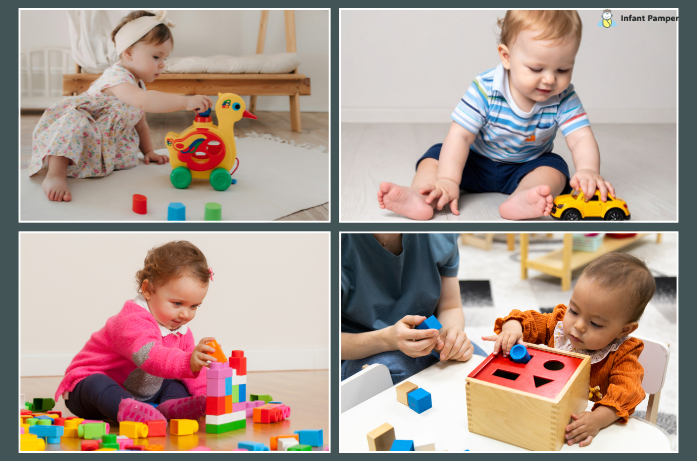
Montessori Toys for 1-Year-Olds (12–18 Months)
Toddlers at this stage are building on body control and are thus discovering hands and senses. Choose toys that promote sensory exploration and motor development.
Recommended Toys:
1. Object Permanence Box
Here, the toddler drops a ball in the hole and watches it reappear, thereby understanding the concept that things still exist even when they cannot be seen.
2. Wooden Ring Stacker or Peg Toy
Your child places rings or pegs on a pole. It builds hand eye coordination and imparts knowledge about sizes and order.
3. Sensory Balls and Textured Blocks
The toddler can touch and squeeze these soft balls or blocks with varying textures. They are perfect for tactile exploration.
4. Push and Pull Toys
Toys with wheels that your toddler can push or pull. Perfect for encouraging crawling, standing, and first steps.
Montessori Tip: Encourage the toddler to repeat the same activity many times. The more repetition, the stronger the neural pathway becomes.
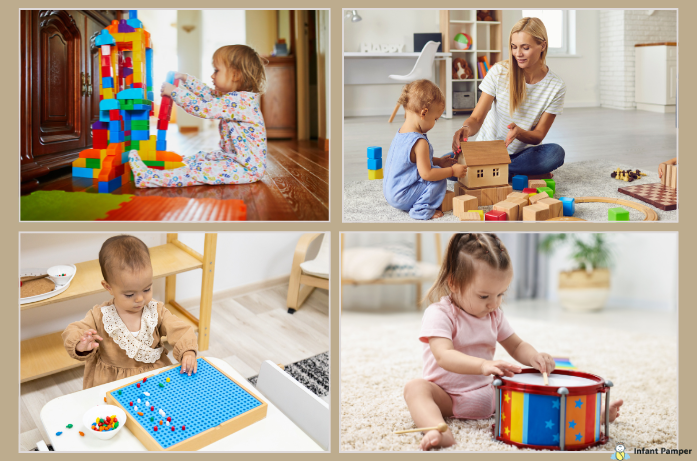
Montessori Toys for 2-Year-Olds (18–24 Months)
At the age of two years, toddlers start acting somewhat independently, developing fine motor skills, and begin to recognize patterns, shapes, and routines.
Recommended Toys:
5. Nesting Cups and Stacking Blocks
Promote problem-solving and spatial reasoning.
6. Wooden Puzzles (with knobs)
Encourage shape recognition and logical thinking.
7. Screwdriver Board or Twist Toys
Strengthen hand muscles and coordination.
8. Simple Musical Instruments (like maracas or xylophones)
Stimulate auditory development and rhythm.
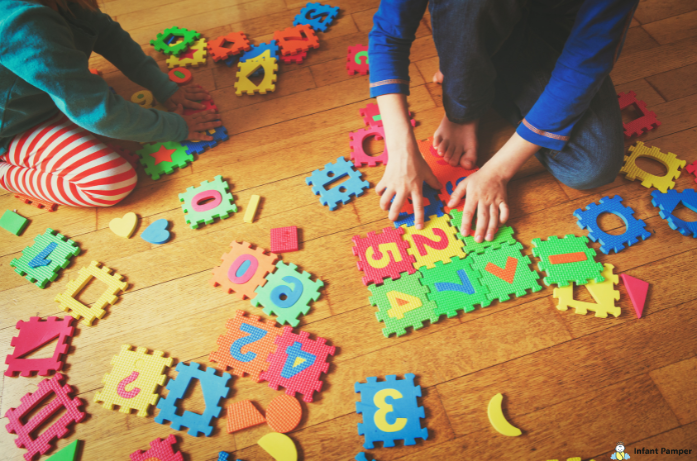
Montessori Toys for 3-Year-Olds (24–36 Months)
Three-year-olds kids love to assume roles, tell stories, and imitate adults. This turning point is an ideal moment to begin acquainting the child with practical skill toys.
Recommended Toys:
9. Montessori Practical Life Toys
Items like mini brooms, watering cans, and child-safe kitchen tools.
10. Lock and Latch Boards
Build dexterity and sequencing skills.
11. Lacing Beads or Buttoning Frames
Develop pre-writing skills and concentration.
12. Busy Boards with Zippers, Buckles, and Switches
Provide multiple activities in one for fine motor practice.
Educational Insight: Play that mimics real life is key at this stage. It boosts both problem-solving and emotional understanding.
Montessori Play Ideas You Can Do at Home (No Special Toys Needed!)
It is not necessary to buy lots of new toys to follow the Montessori way. Everyday items can easily be turned into learning tools.
DIY Montessori Activities:
- Pouring Water from Pitcher to Glass
Teaches control and coordination. - Transferring Beans with Spoons or Tongs
Strengthens pincer grasp and patience. - Sorting Buttons or Colored Blocks by Shape/Color
Supports early math and classification. - Helping Fold Towels or Match Socks
Builds independence and responsibility.
Parenting Tip: Engaging your toddler in daily household chores is a Montessori idea whereby kids should actively participate in daily life.
Creating a Montessori Play Environment at Home
Montessori-type play areas are not very expensive. The focus should be on an organized, calm atmosphere and on accessibility.
Setup Tips:
- Use low shelves so toddlers can access Montessori toys for toddlers independently.
- Offer limited toy choices (rotate weekly) to avoid overwhelm.
- Prefer natural-colored, wooden Montessori toys over flashy plastics.
- Offer child-sized furniture so they can clean up after themselves.
FAQs: Montessori Toys & Toddler Development
Q.1 Are Montessori toys worth it?
Absolutely. These educational toys for toddlers grow with your child, offering both play and long-term developmental value.
Q.2 Can Montessori toys improve speech and language?
Yes. Many Montessori toddler activities promote verbal expression through storytelling, pretend play, and real-life communication.
Q.3 Is it okay to mix Montessori toys with regular toys?
Yes, but keep balance. Too many flashy or noisy toys can distract from focused Montessori inspired play recommended by the Association Montessori Internationale (AMI).
Final Thoughts
Montessori toys for toddlers are more than playthings, they’re powerful tools that nurture independence, curiosity, and focus. With the right toys and a simple Montessori learning at home setup, parents can turn everyday play into meaningful growth.
With a Montessori-style environment set up at home and the right toys apt for their stage of development, early learning activities go hand in hand with helping kids build the confidence, focus, and curiosity needed to thrive.
Whether you’re new to Montessori or just exploring new toddler toy ideas, this approach fits beautifully into any home.
Disclaimer: his article is for general informational purposes only. Always supervise toddlers through their playtime and check with your pediatrician if development milestones are of concern.
Infant Pamper Nurturing Toddlers with Care, Love, and Learning
